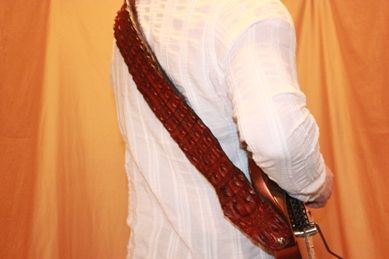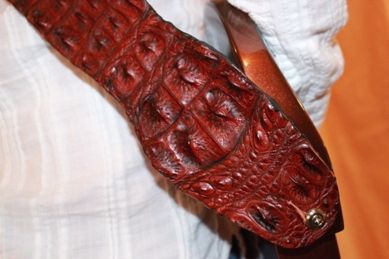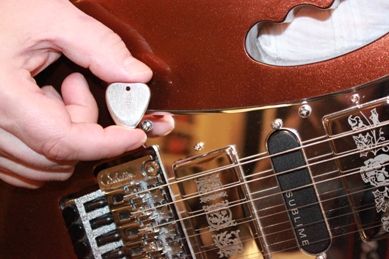THE EXTRAS
Gator Strap
There was a focus on making this a complete project and playing experience, which meant outfitting the guitar with a strap that was of the highest caliber and had a sense of a Victorian Naturalist element. I wanted something that was out of the ordinary and eye-catching and what I found through
www.AlligatorJakes.com (sister site
www.OstrichMarket.com) was almost breath-taking! Made to my specs (but with steel hardware buckle and rivet screws to allow for some adjustment if necessary), the result was a hornback alligator strap dyed dark sport rust for that true vintage look (chocolate brown may have matched the guitar better, but there’s something about that vintage look of the sport rust that I couldn’t resist). The design is reminiscent of two alligator heads on either end of the strap with the hornback ridges representing the raised eye ridges.



This incredible strap is made of three layers. The outer layer is alligator that came from the northern region of the Everglades. It takes two alligator backstraps (the horn section) to make one guitar strap because the back of the neck (the ‘medallion’) of one gator is used for each end section of the strap. The underside is burnished cowhide, which adds to the ‘finish,’ rigidity and strength. What I did not expect was the soft ¾ inch New Zealand lamb’s wool padding along the inside to increase comfort while playing even the heaviest of guitars.
Although photos of the strap were sent to me prior to shipping, I was not prepared for what I saw and felt as it came out of the box. The quality of craftsmanship, the three-dimensional texture, and the depth of color impressed me as much as any quality guitar (custom or stock) that I have seen – yes, I’m comparing the eye-popping appearance of this strap to that of a guitar! As well, I’ve purchased quality stock guitar straps, and had custom straps made in the past, but Alligator Jakes have taken the meaning of ‘custom guitar strap’ to a completely different level. Although some may balk at the use of alligator to make a strap, Alligator Jakes use only those gators that are harvested for meat and other products, and are not on the endangered list (this is no different than with cows, for all those leather strap, jacket, boot and purse connoisseurs).
Silver Plectrum
If the guitar was to be adorned with solid silver hardware, it made me think of having a plectrum that would compliment this look. I never tried a silver plectrum, thinking perhaps that it may be too hard or metallic sounding. The highest grade plectrums, as well as the most diverse collection, come from
www.Timber-Tones.com. This company is known for its vast array of exotic wood plectrums, such as maple and ebony, but it recently released its Treasure Tone collection – in silver, gold and platinum!
With the silver Treasure Tone in hand, I was amazed at what I heard. The note definition was beyond anything I’ve experienced before, and I have used picks from many ‘custom’ shops. It did not produce that clicky, metallic-sound most people would expect from a metal plectrum. In the past I have used a pick with a stainless steel tip (which did give a harsh sound that limited it to harder, heavier music so that the distortion would cover up any ambient noise), whereas the silver Treasure Tone is in a league of its own.

The weight and thickness of the pick makes it obvious between the fingers, but it takes only moments to get used to. In fact, the weight of the plectrum seems to provide balance and guidance in the hand when picking quickly or skipping strings. The curved indentation of the pick makes for a solid grip, but it is the tapered honed edge that allows for quick and rapid pick attack.
The Treasure Tones definitely are more expensive than traditional picks, because of the precious metal content, but insofar as the silver plectrum is concerned, it is no more costly than an inexpensive pedal. And why do we buy pedals? To alter or enhance a guitar’s tone. Consequently, the investment of a silver Treasure Tone is akin to buying a pedal, with improved tone and note definition being the eventual outcome!
The Case
Take a standard guitar case and hand it over to an artist, and you have the potential for a one-of-a-kind creation. Previously, Scott Ouderkirk developed a Hendrix case, to coincide with a Hendrix Tribute guitar that Stephen Casper built for me previously, and I knew Scott would do justice to Steve Vai. Not only did he come up with his own creative interpretation, but Scott investigated Vai’s background and found out that the virtuoso guitarist enjoyed beekeeping as a hobby. Various sketches developed with a final design that incorporated Vai’s two passions… guitar playing and beekeeping… now that is original! I liked the photos Scott sent me, but the detail in the shading really popped out when I saw the case in person, which now is on display in my studio (beside the Hendrix case).

Scott’s custom cases typically involve a three-step process. First the case is primed white, thus resulting in a ‘drawing’ area. Scott then sketches (using both charcoal pencil and fingers) onto the primer, and usually within one sitting to keep his artistic spontaneity intact. (For color paintings, a guiding sketch is drawn and then the paint is applied on top with a brush.) The last step is to seal the drawing with several layers of a clear coating to protect the one-of-a-kind image.
For more information, or to consult with Scott for your unique guitar case, visit:
www.ScottOuderkirk.com.
--------------------------------------------------------------------------------



